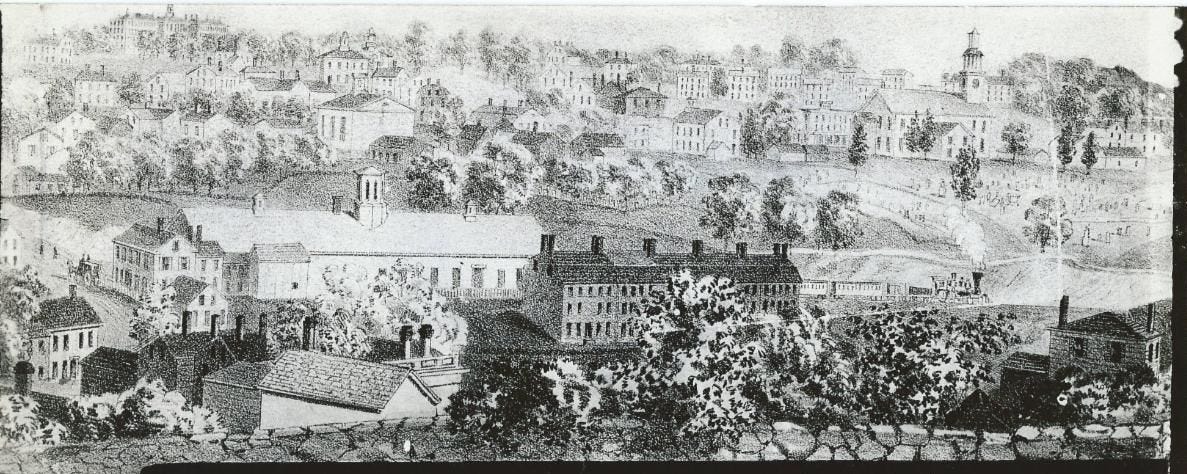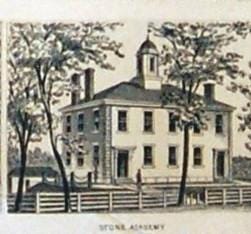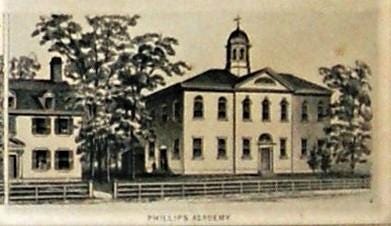Welcome to History Buzz! We hope you enjoy the new format. We love to hear from you, so please leave comments or send an email to HistoryBuzz@andoverhistoryandculture.org.
There's no place like home...
A question came in recently referring to a photo printed in the Andover Townsman newspaper of June 2, 1988. The question referenced the stone wall in the foreground and asked where the view had been taken. The printed newspaper caption indicated that the photo was of a lithograph in our collection.
As it turned out the image was only part of the story.
The photo is but a section of this lithograph - Andover Mass from the North-West. Looking at the lithograph gives a more complete view of Andover circa 1858.
The lithograph was sketched by artist J. P. Newell, printed by lithographer J. H. Bufford, and published by W. F. Draper.
John Perry Newell was a prolific lithographic artist during the late 1800s. Born in Newport, RI (circa 1830), Newell apprenticed with John H. Bufford in Boston beginning in 1848. He became one of Bufford’s main artists producing many harbor scenes and town views throughout Rhode Island and Massachusetts. Even after he left Bufford’s company to sketch on his own, Newell continued to provide art to Bufford.
John Henry Bufford (1810-1870) was born in Portsmouth NH. Interested in drawing and painting as a young man, he moved to Boston in 1829 to apprentice with William and John Pendleton and learn the art of lithography.
Lithography was a young printing industry in the US in the early 1800’s. The Pendleton brothers' print shop along with J. H. Bufford became leading lithographers in New England.
Basically, lithography is a process of transferring a drawn image using stone plates. It dates back to 1769, when Alois Senefelder, a Bavarian playwright realized that he could duplicate scripts by using a grease pencil to write on limestone and then printing the words by inking the stone to transfer to paper. (If you want to learn the step by step details of lithography, check out this video on the Metropolitan Museum of Art’s website.
In the case of our lithograph, duplicates of Newell’s and Bufford’s original lithograph of Andover Mass from the North-West were published by Warren Fales Draper (1818–1905), a publisher and philanthropist in Andover MA for nearly 50 years.
This lithograph dates from 1857-1880, the time period when Newell was drawing for Bufford in Massachusetts and Rhode Island. The drawing was sketched from the “back land of Deacon Peter Smith.” Peter Smith, along with his brother, John and good friend John Dove, were the founders of the linen textile mill, Smith and Dove.
The Boston & Maine Railroad depot is the long building with a cupola, in the front center of the image, just beyond the stone wall. The Boston & Maine Railroad had recently added a new rail line connecting Andover with Lawrence and Boston. Look closely and you can see the steam train heading south just to the right.
Adjusting for some artistic license on the perspective, Newell captured Andover as the Till, Mill, and Hill town that it was in the late 1800s. The pastoral foreground gives way to the town with its chimneys and churches.
In the middle left is Free Christian Church, founded by John Smith and others who wanted to have a church free from any connection with slavery. The white, spire structure looks similar to the South Church of today. Just to the right and back, the Baptist Church on Essex St can be seen. South Church is on the far right. Its bell tower with the clock still tops the church today, although today’s building is the fourth structure.
Further back, seemingly beyond the town, Newell has drawn the Hill. In almost the center of the lithograph is a large, multi-storied building with a cupola, representing the four schools that were there at the time.
Oh, and the stone wall so conspicuous in the foreground? Parts of it can still be seen along Shawsheen Rd. where Peter Smith’s house once stood with an excellent view from the northwest looking southeast over the town.
Below the main lithograph of Andover, Newell added a banner showing some of the notable buildings in town.
Punchard Free School
Built and opened in 1856 on Bartlet Street where the Town Offices now stand. It was built from the $50,000 trust bequeathed by Benjamin Punchard who had seen the need for Andover to have a public, free, co-educational high school.
Abbot Female Seminary
Abbot was founded in 1828, when the community called for a “Female Academy to regulate the tempers, to improve the taste, to discipline and enlarge the minds and form the morals of youth.” It served as a private school for young women until 1973 when it merged with Phillips Academy. The original 3 buildings are still on School Street and part of the Phillips Academy campus.
Andover Theological Seminary
One of the three schools on Academy Hill, it was founded in 1808, and offered a post-baccalaureate education of the ministry. It was begun by the Congregational Church in response to the seemingly liberal Universalist training of ministers at Harvard. When the school moved to Cambridge in 1908, the buildings became part of the Phillips campus. Foxcroft Hall, Pearson Hall and Bartlet Hall are still in use today.
Stone Academy
This building once sat on the corner of South Main Street and Chapel Ave, next to the Chapel. It was a granite building designed by Squire Samuel Farrar and built in 1829. Robert A. Domingue's 1990 book, Phillips Academy Andover Massachusetts, an illustrated history of the property, notes that the original purpose of the building was to house the English Classical School. It was to be a Teacher’s Seminary separate from Phillips Academy and the Theological Seminary. It ultimately became the Phillips Academy English Department building. Stone Academy was destroyed by fire in 1863.
Phillips Academy
Founded in 1778 by Samuel Phillips, Jr. and Eliphalet Pearson, Phillips Academy’s mission was to “promote true piety and virtue” and educate “youth from every quarter.” The oldest incorporated boarding school in the country, Phillips Academy now covers 140 acres, with 160 buildings.
All in all, there is so much more to that one photograph in the newspaper than meets the eye.
Do you recognize other buildings in this lithograph of Andover? Want to know their history? Andover’s Historic Preservation Committee has a great website with fun information about the buildings and community of Andover - preservation.mhl.org.













Wow! That's quite an article, Marilyn!!! Lots and lots of good research!! Congrats!!
Joan